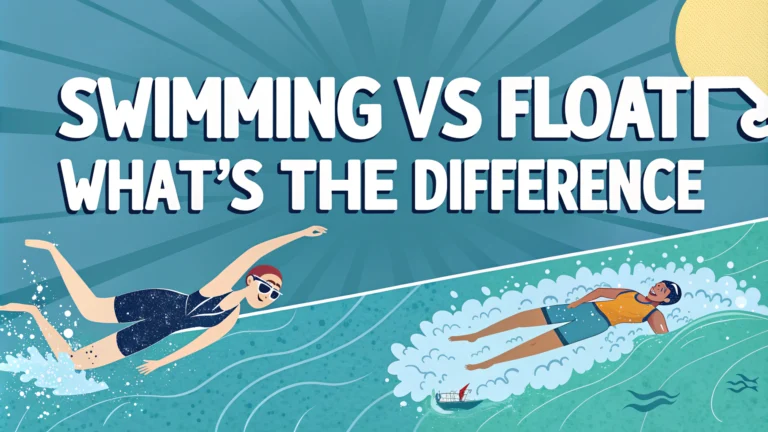Many people wonder what distinguishes **swimming** from **floating** in water. While both activities involve being in water, they require different skills and serve distinct purposes. Learning the difference helps improve water safety and technique.
Understanding these two water activities can make you more confident and safer in pools, lakes, or oceans. **Proper technique** in both skills forms the foundation for water safety and aquatic activities.
Key Differences Between Swimming and Floating
**Swimming** involves active movement through water using coordinated arm and leg movements. **Floating** is a passive activity where the body remains still while being supported by water’s natural buoyancy. The main distinction lies in **energy expenditure** – swimming requires constant effort, while floating conserves energy.
Swimming vs Floating Comparison
| Aspect | Swimming | Floating |
|---|---|---|
| Energy Use | High | Low |
| Movement | Active | Passive |
| Purpose | Travel/Exercise | Rest/Survival |
Basic Floating Techniques
The key to successful floating lies in proper body position and relaxation. **Back floating** and **front floating** are two primary positions that serve different purposes.
- Relax muscles and breathe steadily
- Keep your head tilted slightly back
- Spread arms and legs slightly
- Maintain a horizontal body position
Essential Swimming Fundamentals
**Proper form** and **breathing technique** create the foundation for efficient swimming. Basic strokes include freestyle, breaststroke, and backstroke.
- Maintain streamlined body position
- Coordinate breathing with stroke movements
- Use leg kicks for propulsion
- Keep movements smooth and rhythmic
Safety Considerations for Water Activities
**Water safety** remains a top priority whether swimming or floating. Understanding basic safety rules helps prevent accidents and builds confidence.
- Never swim alone – use the buddy system
- Stay within designated swimming areas
- Know your physical limits
- Check water conditions before entering
Equipment and Gear Selection
The right **equipment** enhances both swimming and floating experiences. Choose gear based on your activity and skill level.
| Item | Purpose | Recommended For |
|---|---|---|
| Goggles | Eye protection | Swimming |
| Life jacket | Safety | Both |
| Swim cap | Hair protection | Swimming |
Practice Exercises for Improvement
Regular **practice** helps develop better technique and confidence in water. Start with basic exercises and progress gradually.
Floating Practice
- Wall-assisted floating
- Partner-assisted practice
- Timed floating exercises
Swimming Practice
- Kick board drills
- Breathing exercises
- Stroke refinement
Moving Forward with Water Skills
Building **water confidence** takes time and consistent practice. Focus on mastering basic techniques before advancing to more complex skills.
- Set realistic goals for improvement
- Track your progress regularly
- Join swimming classes or groups
- Practice in different water environments
> “Learning proper technique early prevents developing bad habits that are harder to correct later.”
Remember to maintain a balanced approach between swimming and floating skills, as both serve important purposes in water safety and enjoyment.
Swimming vs Floating FAQs
General FAQs
Q: What is the main difference between swimming and floating?
A: Swimming is an active movement through water using specific strokes and muscle power, while floating is a passive state where the body remains buoyant on water’s surface with minimal movement.
Q: Why do some people float better than others?
A: Body composition affects floating ability. People with higher body fat percentages float more easily because fat is less dense than water. Muscle mass and bone density can make floating more difficult.
Q: Can all humans naturally float?
A: Most humans can float naturally, but individual factors like body composition, lung capacity, and water density affect floating ability. Salt water makes floating easier than fresh water.
Technique-Related FAQs
Q: How do I learn to float on my back for beginners?
A: To float on your back:
- Lean back slowly in shallow water
- Keep your ears in the water
- Arch your back slightly
- Keep your arms out to the sides
- Take slow, deep breaths
Q: What muscles do you use when swimming vs floating?
A: Swimming engages multiple muscle groups:
- Core muscles
- Shoulder muscles
- Back muscles
- Leg muscles
- Tense muscles
- Higher muscle/bone density
- Incorrect body position
- Shallow breathing
- Panic or anxiety
While floating requires minimal muscle engagement, mainly using core stability muscles.
Q: How many calories does swimming burn compared to floating?
A: Swimming burns 400-700 calories per hour depending on intensity and stroke type. Floating burns approximately 40-50 calories per hour.
Q: Why do I sink when I try to float?
A: Common reasons for sinking include:
Safety FAQs
Q: Is floating safer than swimming for beginners?
A: Floating is generally safer for beginners as it requires less energy and skill. However, proper supervision is still essential for water safety.
Q: Can you float if you can’t swim?
A: Yes, floating is a basic water survival skill that doesn’t require swimming ability. It’s often taught before swimming techniques.
Q: How long can a person safely float in water?
A: A person can float indefinitely if the water is warm enough to prevent hypothermia. However, exhaustion and dehydration become concerns after several hours.
| Activity | Energy Required | Skill Level |
|---|---|---|
| Floating | Low | Basic |
| Swimming | High | Advanced |



















